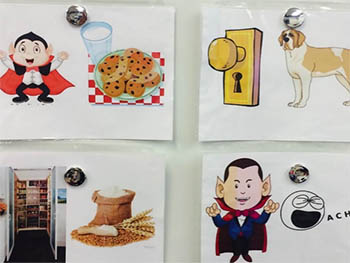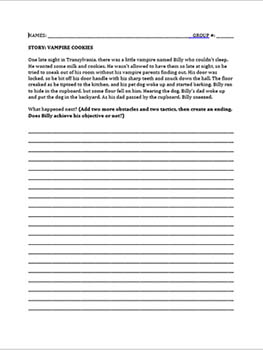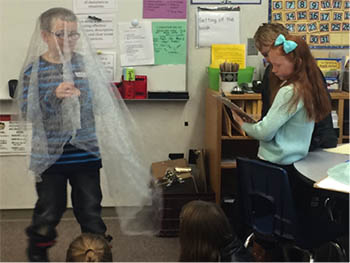SUBJECTS
GRADE
Show Results
Complete the Story: Vampire Cookies

Lesson Summary
- Learn to apply the value of a story’s R.O.O.T.: relationships, objectives, obstacles, and tactics.
- Write and act out a half-finished story about a vampire by adding obstacles and tactics.
Lesson Plan and Procedure
Lesson Key Facts
- Grade(s): 4, 5
- Subject(s): Drama, English Language Arts
- Duration of lesson: 55 minutes
- Author(s): Haley Flanders Anderson
Note: Make sure you have your materials and enough room for the students to move.
Warm-Up/Hook
Teacher: We are going to play a game called “Stream of Consciousness.” We will create a story as a class, one word at a time. Please sit in a circle. I will say the first word in our story, and then we will go clockwise around the circle. Each person will say only one word to continue the story. For example (point to one student at a time, moving clockwise as they each say a word), “Once . . . there . . . was . . . a . . . bird . . . that . . . needed . . . a . . . home.” Then a new sentence will start. Don’t think too hard. Just say what comes to your mind. Each person will have a chance to add a word.
Say a word. Go around the circle a couple of times to make the story longer. Then perhaps try a round in which the students each say a whole sentence instead of one word.
Reflection
Teacher: What was hard about this activity? What was easy? What was surprising about the story we created? What was your favorite part? What do you think happens next? Just like this game, we are going to do a fun activity in which we complete an unfinished story. We will get into groups and then act it out.
Introduction
 Teacher: There are six major questions that we try to answer as we read, watch, or write a story: who, what, when, where, why, and how. Answering these questions gives the story important details and helps you understand the story. A great way to answer these questions is through establishing R.O.O.T. for your story. What do roots do for a plant? (Listen to students’ responses.) Likewise, the root of a story keeps it grounded and full of key details. R.O.O.T. is an acronym for relationships, objectives, obstacles, and tactics.
Teacher: There are six major questions that we try to answer as we read, watch, or write a story: who, what, when, where, why, and how. Answering these questions gives the story important details and helps you understand the story. A great way to answer these questions is through establishing R.O.O.T. for your story. What do roots do for a plant? (Listen to students’ responses.) Likewise, the root of a story keeps it grounded and full of key details. R.O.O.T. is an acronym for relationships, objectives, obstacles, and tactics.
Explain the four terms of R.O.O.T., and ask the students for examples from stories.
- Relationships: Connections to people, places, and things
- Objectives: What the character wants
- Obstacles: Things that keep the character from getting what he or she wants
- Tactics: Choices the character makes to try to get what he or she wants
Instruction/Rehearsal
 Teacher: The story you are going to complete and act out today is called “Vampire Cookies.” It goes like this: “One late night in Transylvania, there was a little vampire named Billy who couldn’t sleep. He wanted some milk and cookies. He wasn’t allowed to have them so late at night, so he tried to sneak out of his room without his vampire parents finding out. His door was locked, so he bit off his door handle with his sharp teeth and snuck down the hall. The floor creaked as he tiptoed to the kitchen, and his pet dog woke up and started barking. Billy ran to hide in the cupboard, but some flour fell on him. Hearing the dog, Billy’s dad woke up and put the dog in the backyard. As his dad passed by the cupboard, Billy sneezed.”
Teacher: The story you are going to complete and act out today is called “Vampire Cookies.” It goes like this: “One late night in Transylvania, there was a little vampire named Billy who couldn’t sleep. He wanted some milk and cookies. He wasn’t allowed to have them so late at night, so he tried to sneak out of his room without his vampire parents finding out. His door was locked, so he bit off his door handle with his sharp teeth and snuck down the hall. The floor creaked as he tiptoed to the kitchen, and his pet dog woke up and started barking. Billy ran to hide in the cupboard, but some flour fell on him. Hearing the dog, Billy’s dad woke up and put the dog in the backyard. As his dad passed by the cupboard, Billy sneezed.”
 As you read, display visuals (if you desire) and explain that the story is typed up on the student worksheet.
As you read, display visuals (if you desire) and explain that the story is typed up on the student worksheet.
Teacher: Your goal is to write what happens next. In your groups, you will add at least two more obstacles and two more tactics, then create an ending. Does Billy achieve his objective or not? After you write your ending, rehearse how you want to act it out. Choose a narrator and actors. You will have a piece of fabric to use in your scene as a prop or costume piece. As you write and rehearse, focus on descriptive words that answer the six questions. Then consider how to animate your voice and body to create your character.
Organize the class into groups of four or five. Give each group a worksheet and a piece of fabric.
Activity/Performance
Take turns allowing the groups to perform their stories for one another. In order to save time, number the groups on their sheet so the order of performance is already decided.  Rather than acting out the entire scene, each group will act out just the part they created for the ending.
Rather than acting out the entire scene, each group will act out just the part they created for the ending.
Conclusion
Teacher: What was fun about this activity? What was difficult? What did you learn about the importance of answering the six questions of storytelling? How did this activity convey the need for R.O.O.T. in a story? What relationships did we see? What objectives? What obstacles? What tactics? Other than your own group, which group had your favorite ending, and why?
Learning Objectives
- Establish a situation and characters who respond to actions.
- Use descriptions and concrete words.
- Provide a conclusion.
- Develop imagination.
- Write a script that focuses on the six questions of storytelling.
- Define roles and work in a group.
- Communicate character and story through physicality.
- Demonstrate audience skills.
Utah State Board of Education Standards
This lesson can be used to meet standards in many grades and subject areas. We will highlight one grade’s standards to give an example of application.
Grade 4 English Language Arts
- Standard 4.W.3: Write narrative pieces to develop real or imagined experiences or events using effective technique, descriptive details, clear event sequences, and provide a resolution.
- Orient the reader by establishing a situation and introducing a narrator and/or characters; organize an event sequence that unfolds naturally.
- Use dialogue and description to develop experiences and events or show the responses of characters to situations.
- Use a variety of transitional words and phrases to manage the sequence of events.
Grade 4 Drama
- Standard 4.T.CR.1: Develop imagination to create artistic ideas and work.
- Standard 4.T.CR.3: Write or record simple dramas that include the five Ws of who, what, where, when and why.
- Standard 4.T.CR.4: Define roles, identify responsibilities, and participate in group decision making.
- Standard 4.T.CR.5: Create character through imagination, physical movement, gesture, sound and/or speech and facial expression.
- Standard 4.T.CR.7: Recognize that participating in the rehearsal process is necessary to refine and revise.
- Standard 4.T.P.3: Observe, listen, and respond in character to other actors throughout a scripted or improvised scene.
- Standard 4.T.P.4: Communicate meaning using the body through space, shape, energy and gesture.
- Standard 4.T.R.1: Demonstrate audience skills of observing attentively and responding appropriately.
Equipment and Materials Needed
Additional Resources
For more practice on finishing incomplete stories or tips for storytelling in general, visit the following websites:
- https://www.stuartstories.com/activities/finishme.html
- http://www.storyarts.org/lessonplans/lessonideas/index.html
- https://www.teachingenglish.org.uk/article/a-creative-writing-activity-a-dark-stormy-night
Image References
- Image 1: https://www.shutterstock.com/image-photo/little-vampire-girl-big-fangs-making-1323840380
- Images 2–5: Haley Flanders Anderson.

www.education.byu.edu/arts/lessons
 Download
Download